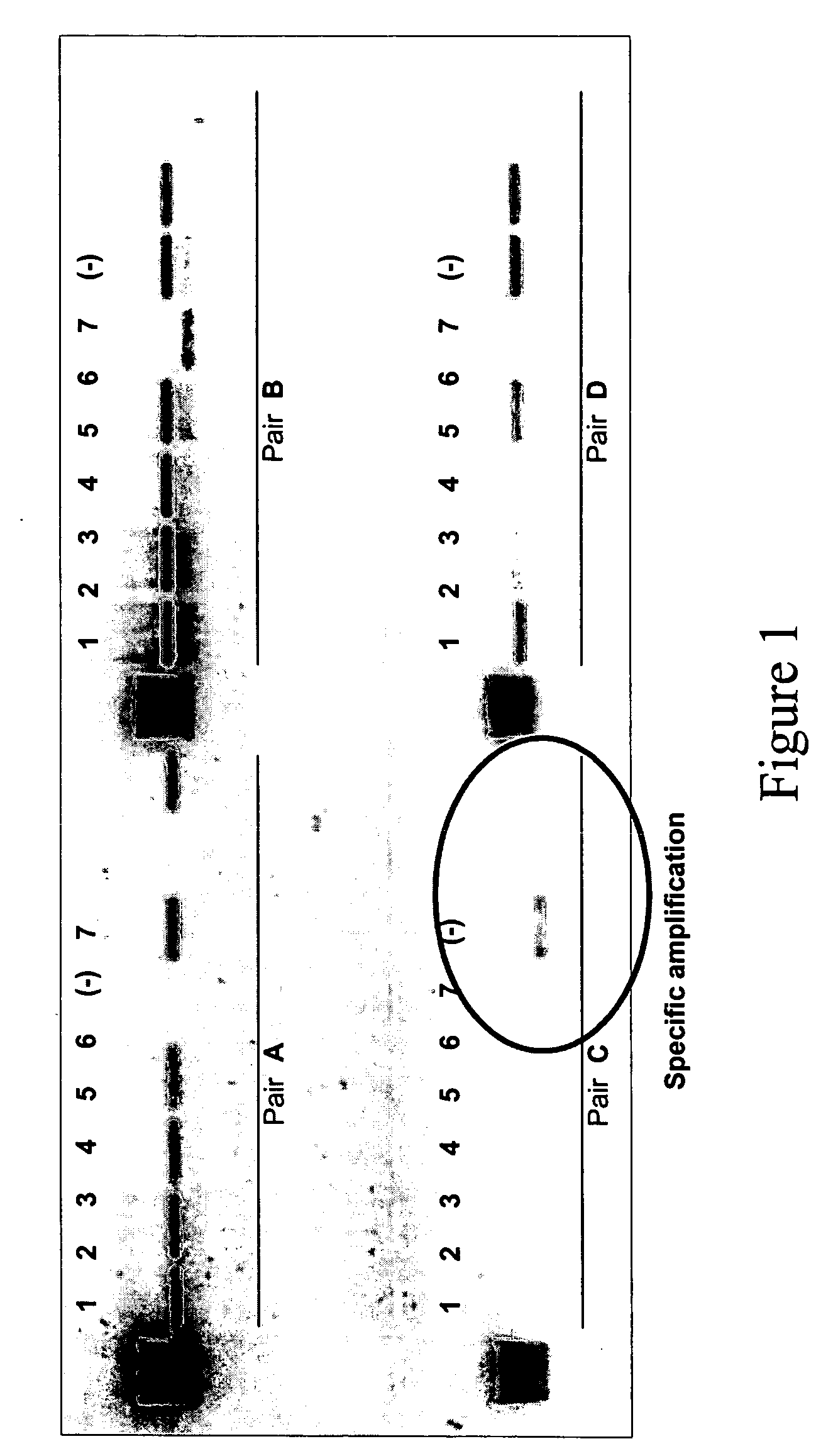Method for the design of oligonucleotides for molecular biology techniques
a molecular biology and design method technology, applied in the field of molecular biology and design of oligonucleotides, can solve the problems of inability to meet the requirements of the application
- Summary
- Abstract
- Description
- Claims
- Application Information
AI Technical Summary
Benefits of technology
Problems solved by technology
Method used
Image
Examples
examples
[0087] Example 1. Design of a specific oligonucleotide for bacteria belonging to Leptospirillum genus.
[0088] A new database was obtained with data comprising only 16S sequences selected from the public NCBI GenBank database. This new database is the “evaluation database”.
[0089] All sequences that come from bacteria belonging to Leptospirillum genus, 44 sequences in this case, were selected to be the “design database”.
[0090] The set of 20-letter oligonucleotides that are present in each of the sequences was determined, discarding those sequences appearing more than once within each sequence, considering up to 3 substitutions, using Algorithm 1. These oligonucleotides are the “candidate oligonucleotides”, which were evaluated according to their thermodynamic stability using the algorithm described in M. Zuker. (2003) Mfold web server for nucleic acid folding and hybridization prediction, Nucleic Acids Res. 31 (13), 3406-15. All candidate oligonucleotides with ΔGh values lower than ...
example 2
Identification of bacteria belonging to Leptospirillum genus in a metagenomic sample.
[0091] The reference database was searched looking for said 12 oligonucleotides designed in Example 1, and the following Sensitivity and Selectivity values were obtained:
TABLE 1OligoNTRSensitivitySelectivityRate154374484.1%68.5%57.6%268374484.1%54.4%45.8%366374484.1%56.1%47.1%458374484.1%63.8%53.6%557374484.1%64.9%54.6%656374484.1%66.1%55.6%754374484.1%68.5%57.6%868374484.1%54.4%45.8%966374484.1%56.1%47.1%1058374484.1%63.8%53.6%1157374484.1%64.9%54.6%1256374484.1%66.1%55.6%
N = number of sequences belonging to the target taxonomical group that are present in the evaluation database.
T = number of sequences belonging to the target taxonomical group to which said oligonucleotide hybridizes; and
R = total number of sequences to which said oligonucleotide hybridizes.
[0092] According to these results, oligonucleotides 1 and 7 were selected as best candidates. Both were synthesized, fluorescently labe...
example 4
Other Results.
[0097] Primer design for different taxons.
[0098] The described method has been used for the design of many primer pairs specific for different taxons, like Acidithiobacillus thiooxidans, Acidithiobacillus ferrooxidans, Leptospirillum sp., Acidiphillum sp. In Table 3 thermodynamic and specificity requirements are shown corresponding to 4 oligonucleotides pairs or primers that were designed using the method of the invention to perform a specific PCR for each microorganism indicated in said Table, namely A. ferrooxidans, A. thiooxidans, Leptospirillum sp. y Acidiphillum sp. These oligonucleotides are useful as PCR primers for said taxons.
[0099] Table 4 shows sequences of selected specific primers.
TABLE 3SenseAntisenseSizeDimerSpecificityPrimerTmΔGdΔGhPrimerTmΔGdΔGhMinMaxΔGxSensitSelectRateOrgSpA. ferrooxidans PrimersTH674.5F62−3.441.53TH1116.11R60−3.230.57444444−9.984.00100.004.0011A. thiooxidans PrimersTH1143.9F68−2.84−0.79TH1393.1R62−2.180.36250250−7.5320.00100.00...
PUM
| Property | Measurement | Unit |
|---|---|---|
| Fraction | aaaaa | aaaaa |
| Electrical conductance | aaaaa | aaaaa |
| Length | aaaaa | aaaaa |
Abstract
Description
Claims
Application Information
 Login to View More
Login to View More - R&D
- Intellectual Property
- Life Sciences
- Materials
- Tech Scout
- Unparalleled Data Quality
- Higher Quality Content
- 60% Fewer Hallucinations
Browse by: Latest US Patents, China's latest patents, Technical Efficacy Thesaurus, Application Domain, Technology Topic, Popular Technical Reports.
© 2025 PatSnap. All rights reserved.Legal|Privacy policy|Modern Slavery Act Transparency Statement|Sitemap|About US| Contact US: help@patsnap.com


